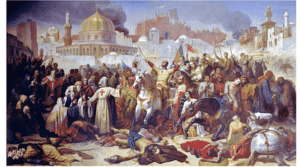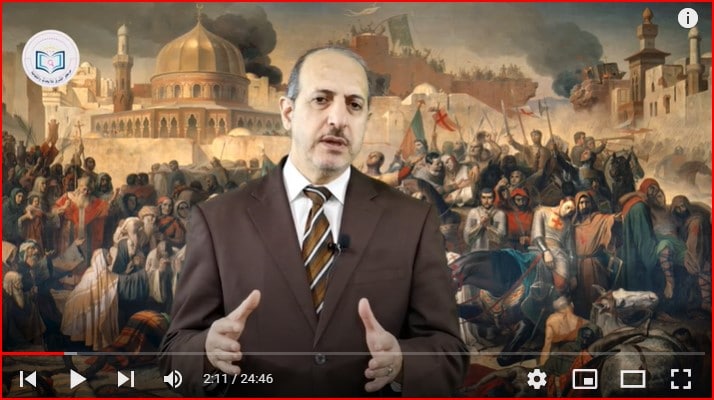Lecture entitled “The Crusader Occupation of Jerusalem”
(Lecture video below)
The arrival of the First Crusade to the walls of the Holy City and its siege in 1099 AD
The vanguards of the Crusader forces reached the walls of the holy city on the seventh of June 1099 AD and began to besiege and restrict it until these forces were finally able to storm its walls.
Muslims realized the danger of the First Crusade on Palestine in general andJerusalem in particular. And for this they took a set of measures desiring to protect and defend the city, These measures include:
-
Obliterate and spoil what is located around the city of spring and spring water to prevent the Crusaders from benefiting from it.
-
Hide cattle and herds in caves and caves.
-
Strengthening the fortifications of the city and ensuring the integrity of its walls.
-
Christians were driven out of the city for fear of collaborating with the Crusaders.
The Crusaders seize the city and massacre its inhabitants
The Crusaders captured the city on Friday, the fifteenth of July 1099 AD, about forty days after its siege.
He continued in a lecture entitled “The Crusader Occupation of Jerusalem”
After the success of the Crusaders in storming the city, they committed a horrific massacre against its inhabitants, Where the death toll reached about seventy thousand, according to the historian Ibn al-Atheer, Some Western sources put the death toll in the courtyard of the Al-Aqsa Mosque at ten thousand.
Topographic changes brought about by the Crusaders in Jerusalem
The topographical changes brought about by the Crusaders in Jerusalem can be classified into two categories:
1. Functional change in some existing buildings to serve new purposes, including: Transforming the Shafi’i school into a church (Saint Anne). Al-Aqsa Mosque became the residence of the Crusader king, Then it became the seat of the Daoist knights The Dome of the Rock Mosque became the temple of the Lord.
2. Construction of new buildings to meet the needs of the new population, including: the construction of a new palace for the Crusader king east of the Tower of David.Built hotels and hostels for European and Eastern pilgrims in different parts of the city. She changed the names of the city’s gates and streets.
St. Anne Church
Settlement of the Crusaders in the city
He continued in a lecture entitled “The Crusader Occupation of Jerusalem”
The massacre committed by the Crusaders in 1099 AD led to the evacuation of the city of all its former inhabitants, They were replaced by the Crusaders who occupied its dwellings and seized everything they found in it. But those who entered Jerusalem did not stay and did not settle all there, Most of those who participated in the capture of the holy city left for their country of origin or for other areas occupied by the Crusaders, especially coastal cities.
According to Crusader historian William al-Suri, “Qatar’s population was noticeably small and living in extreme poverty, as they were too little to occupy one of its streets.”
This, of course, left the Crusaders in the first years after the occupation in a state of fear and insecurity.

What actions did the Crusader King Baldwin I take to solve the problem of the shortage of human personnel in the Holy City?
-
He encouraged Christians living east of the Jordan River to come to the city after promising them better living conditions.
-
The king gave the new residents a large part of the city.
-
He encouraged intermarriage between Eastern Christians and Western Christians.
And we add another thing related to the increase in the population of the Holy City, King Baldwin II in 1120 AD called for the issuance of a law under which all foodstuffs are exempted from customs duties. Especially those coming from them to Jerusalem.
The most important settlements established by the Crusaders in the countryside of Jerusalem
:
-
The settlement of Al-Bireh and was known as “Magna Mahumeria” meaning the Great Devotional Area, The land of this settlement was cultivated with several crops and was subject to the Latin clergy.
-
The settlement of Qubayba was known as “Parva Mahumeria” meaning the minor worship area.
-
The inhabitants of this settlement worked as blacksmiths, carpentry, shoemaking, as well as agricultural and gardening and orchards.







